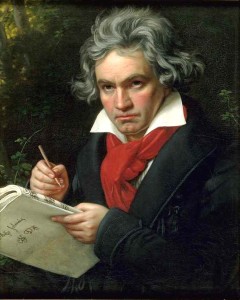Beethoven Sonatas
 Beethoven and his 32 Piano Sonatas have fascinated me ever since I started listening to his symphonies as a teenager and learned Sonata in C minor, Opus 10, No. 1. Beethoven’s music, more than any other, was the soundtrack for my college joys and sorrows. Challenged at age 30 to name my life goals, I realized that learning more Beethoven sonatas was paramount. I began to study Opus 26 and performed it in recital at American University in 1978. In 1993, I performed Opus 90 in my entrance recital for graduate work at Catholic University. Over the last 40 years I have listened to the complete set of Schnabel recordings Steve gave me one Christmas and attended many live performances and master classes. In my studio I have taught the two “easy” ones in Opus 49, plus the “Pathetique” and the “Moonlight.” But that’s only 7 out of 32 that I feel like I know fairly well! Learning (by which I mean listening closely, analyzing and responding, but not performing by memory) the other 25 is like climbing the Himalayas, but I have longed for just such a musical expedition.
Beethoven and his 32 Piano Sonatas have fascinated me ever since I started listening to his symphonies as a teenager and learned Sonata in C minor, Opus 10, No. 1. Beethoven’s music, more than any other, was the soundtrack for my college joys and sorrows. Challenged at age 30 to name my life goals, I realized that learning more Beethoven sonatas was paramount. I began to study Opus 26 and performed it in recital at American University in 1978. In 1993, I performed Opus 90 in my entrance recital for graduate work at Catholic University. Over the last 40 years I have listened to the complete set of Schnabel recordings Steve gave me one Christmas and attended many live performances and master classes. In my studio I have taught the two “easy” ones in Opus 49, plus the “Pathetique” and the “Moonlight.” But that’s only 7 out of 32 that I feel like I know fairly well! Learning (by which I mean listening closely, analyzing and responding, but not performing by memory) the other 25 is like climbing the Himalayas, but I have longed for just such a musical expedition.
In August I was thrilled to read in the New York Times about a free online course on Beethoven Piano Sonatas offered by Jonathan Biss of the Curtis Institute. Every Tuesday for five weeks Coursera posts for me and 35,000 (!) other subscribers an hour’s worth of lectures and demonstrations. Biss is a terrific performer and has obviously lived and breathed this music for most of his 33 years. With carefully chosen examples, he shows how Beethoven tested the limits of sonata forms, harmonies, pianos and players. Each time he plays an example, he ends with a gesture that shows his deep passion for the music and his eagerness to share the treasures he has found. Coursera’s online forums have let me participate in discussions about Beethoven’s accomplishments with people around the world.
Best of all, the lectures have inspired me to play each sonata that he discusses and to listen to various recordings. I downloaded a SyncScore app that provides sound recordings along with synchronized scores for all 32 sonatas. Now I can take Beethoven wherever I go. I have discovered new joys in Opus numbers 7, 28, 31/3, 78, 109 and happily, 10/1, the first sonata I learned. On October 2, I listened to Professor Biss’s last lecture and was moved by his fervent summation:
The reason we come back to great music again and again as players or as listeners is that you can barely ever scratch its surface. That is truer than ever in the case of late Beethoven with its vision of the infinite. I have played Opus 109 for something like seventeen years now, and I feel that I have come only marginally closer to it with time. But there is more sense of fulfillment in inching towards this music than there is in playing just about anything else.
I am now reading Biss’s Kindle Single, Beethoven’s Shadow, and plan to listen to more of his recordings, as well as tune in to hear Curtis students at http://curtisperforms.curtis.edu/. Perhaps I will download Robert Greenberg’s longer course on Beethoven Sonatas from The Great Courses. For now, back to practicing. As Beethoven himself wrote:
He who divines the secret of my music is delivered from the misery that haunts the world.
Leave a Reply